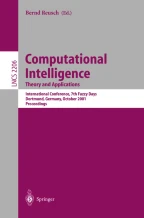Abstract
Meta-learning has been accepted, in the last five years, as a proper machine learning research field. In this concrete area of interest, the way in which different theories, each one produced either with the same algorithm or with many of them, are merged to produce a more accurate model has been the main topic. Now, new emerging techniques got more to do with inductive meta-learning. It is the process of learning from others learning experiences. This kind of learning imposes severe requisites, from the point of view of the software system that would support it. The purpose of this work is to show a software architecture for this type of learning. The architecture will give recommendations for building a system of this kind, that has to tackle with very precise but difficult problems at a time.
Work partially supported by the European Comission through the project FEDER 1FD97-0255-C03-01
Access this chapter
Tax calculation will be finalised at checkout
Purchases are for personal use only
Preview
Unable to display preview. Download preview PDF.
Similar content being viewed by others
References
Hilan Bensusan. Odd bites into bananas don’t make you blind — learning about simplicity and attribute addition. In Upgrading Lerning to the Meta-level: Model Selection and Data Transformation. ECML-98 Workshop Summary., pages 30–42.
Pavel B. Brazdil and C. Soares. A comparison of ranking methods for classification algorithm selection. In ECML-99.
Leo Breiman. Bagging predictors. Technical report, Department of Statistics. University of California., Berkeley, California 94720., September 1994.
Norman Carver and Victor Lesser. The evolution of blackboard control architectures. Technical Report 92-71, CMPSCI, October 1992.
Yoav Freund and Robert E. Schapire. A short introduction to boosting. Journal of Japanese Society for Artificial Intelligence, 14(5):771–780, September 1999.
David Garlan and Mary Shaw. An introduction to software architecture. In V. Ambriola and G. Tortora, editors, Advances in Software Engineering and Knowledge Engineering, pages 1–39, Singapore, 1993. World Scientific Publishing Company.
M. Hilario. An overview of strategies for neurosymbolic integration, 1995.
W. Yeong T. Howes S. Kille. Lightweight directory access protocol. request for comments: 1777. Technical report, Performance Systems International, University of Michigan and ISODE Consortium, March 1995.
Luis Paulo Peixoto. Load distribution: a survey. Technical Report UM/DI/TR/96/03, Departamento de Informática. Escola de Engenharia. Universidade do Minho, 1996.
Salvatore Stolfo, Andreas L. Prodromidis, Shelley Tselepis, Wenke Lee, and Dave W. Fan. JAM:Java Agents for Meta-Learning over Distributed Databases. In David Heckerman, Heikki Mannila, Daryl Pregibon, and Ramasamy Uthurusamy, editors, The Third International Conference on Knowledge Discovery & Data Mining. AAAI Press, August 1997.
A. Suyama, N. Negishi, and T. Yamaguchi. Camlet: A platform for automatic composition of inductive applications using ontologies. In Recent Advances in Metalearning and Future Work. ICML-99 Workshop Summary.
Author information
Authors and Affiliations
Editor information
Editors and Affiliations
Rights and permissions
Copyright information
© 2001 Springer-Verlag Berlin Heidelberg
About this paper
Cite this paper
Botía, J.A., Gómez-Skarmeta, A.F., Valdés, M., Padilla, A. (2001). METALA: A Meta-learning Architecture. In: Reusch, B. (eds) Computational Intelligence. Theory and Applications. Fuzzy Days 2001. Lecture Notes in Computer Science, vol 2206. Springer, Berlin, Heidelberg. https://doi.org/10.1007/3-540-45493-4_68
Download citation
DOI: https://doi.org/10.1007/3-540-45493-4_68
Published:
Publisher Name: Springer, Berlin, Heidelberg
Print ISBN: 978-3-540-42732-2
Online ISBN: 978-3-540-45493-9
eBook Packages: Springer Book Archive
